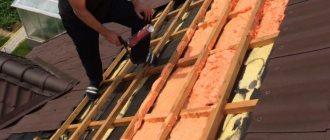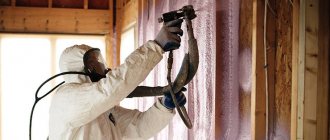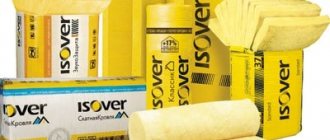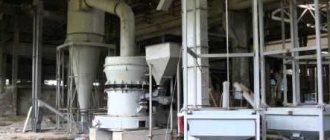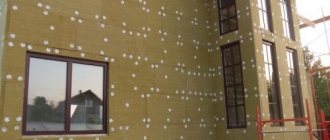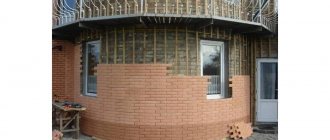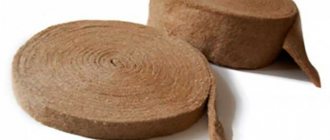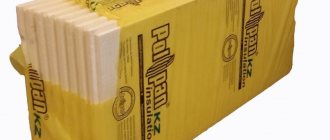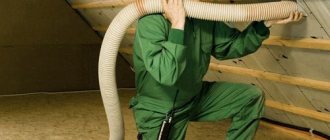Characteristics
In Leroy Merlin, Polinor sprayed insulation is available in two types:
- Sprayed insulation Polinor. Price – 494 rub.
Cylinder volume – 1000 ml. Based on more than 50 user reviews, the product earned a rating of 3.6 out of 5. Among the advantages, users highlight the compactness of the packaging, ease of use, and corresponds to the main declared qualities and properties. Among the disadvantages, consumers note the high cost, defective cylinders are found, skill in use is required, and a pungent odor.
- Sprayed insulation Polinor Home. Price – 415 rub.
The volume of the cylinder is 750 ml. According to users, the product deserves a rating of 3.3 out of 5. Among the advantages, users highlight the compactness of the packaging, simplicity and ease of use, thanks to the presence of a straw that closes cracks well. Among the disadvantages, consumers especially note the high cost and high consumption.
Polynor sprayed insulation can be used to insulate facades, partitions and walls, balconies, interpanel seams, window or door slopes. Setting of the substance and initial drying occurs within 20 minutes. Complete drying of the composition occurs in 12-24 hours.
General main characteristics of Polinor as insulation:
- Low level of water absorption (no more than 0.03% in 24 hours).
- Low vapor permeability.
- The substance is not toxic.
- Density – 18-28 g/m3.
- Belongs to G3 flammability class. The destruction of the material occurs at 120C.
- Good adhesion to any surface - material delamination practically does not occur.
Before use, please note that when reacting with air, the substance greatly increases in volume. The reaction will be more active at high humidity. The finished insulation layer has a closed-cell structure. Up to 70% of the total space is filled with cells.
When using Polinor, additional hydro- and vapor barrier is not required, but it must be taken into account that the material is “afraid” of prolonged exposure to ultraviolet radiation and moisture.
Possibility of using foam fillers
Balloon thermal insulation , although better than its analogues in all respects, was not widely used in the past due to its high cost. And the use of such insulation was limited by the need to use special equipment, which, due to its price and complexity of development, is practically inaccessible outside the professional sphere. Much simpler and more profitable, although not always more convenient, was the use of mineral wool and polystyrene boards, which are made by extrusion.
Then manufacturers began to produce sprayed insulation in compact-sized cylinders, which led to a reduction in the cost of the method. To spray such a mixture of steel, complex installations and specialists in thermal insulation finishing are not needed, since the material itself is filled into small containers and the possibility of manual spraying is provided. Each cylinder is designed to cover one square meter of base (layer up to 60 mm thick). One person can process up to one hundred square meters per day.
Advantages and disadvantages
The main advantages of the material include the following properties:
- The effectiveness of energy saving has been proven (when compared with the use of mineral wool as insulation).
- This is one of the budget methods of insulation, since when used, you do not need to additionally construct a structure or frame. It will not require large expenses for transporting the material or special devices for its installation.
- You don't have to hire a professional to spray insulation. You can do this yourself, the main thing is to strictly follow the instructions. There is also no need for complex labor-intensive preparatory work or careful leveling of the surface.
- Material costs are minimal.
- Condensation does not form on the insulation. It is bioresistant.
Polinor does not have many disadvantages as an insulation material, but before using the material, it is recommended to pay attention to them.
- Water (including frequent precipitation) has a destructive effect on Polinor.
- The material fades quickly when exposed to ultraviolet radiation.
- It is recommended to apply only at temperatures within +15 – +25°C.
- The aerosol should only be applied using personal protective equipment (gloves and a respirator), since the material is dangerous to the skin, respiratory system and eyes.
Material advantages
Sprayed insulation is characterized by high adhesion to any surface.
Construction specialists prefer polyurethane foam in favor of analogues such as insulating shell, matte and solid insulators.
Pros of PPU:
- Ecological cleanliness. The foam does not contain substances harmful to humans and the environment. It can be safely used indoors and outdoors.
- Low thermal conductivity coefficient. This figure is significantly lower than that of such popular insulators as basalt wool and polystyrene.
- Lack of hygroscopicity. The coating does not absorb water and always remains light and dry.
- Excellent sound insulation. The material cuts off street noise and prevents loud sounds from leaving the room.
- Biological inertia. The foam does not harbor fungus and mold; rodents, birds and insects avoid it.
- Resistance to active chemical reagents. The substance does not react to the effects of motor fuel, acids, alkalis, pest control agents, oil and acrylic paints.
- Long service life. Depending on the type and brand of the manufacturer, the service life is 30-50 years. In this case, the foam does not require any maintenance.
- Corrosion protection. Due to its tight fit to the surface, polyurethane foam prevents the formation of condensation on it and the ingress of moisture from the outside.
- No joints or voids. Foam fills all the smallest cracks and holes, covering surfaces with a monolithic layer in which there are no cold bridges.
- Fire safety. The material is not flammable, but upon contact with an open flame it emits toxic fumes.
- Resistance to extreme low and high temperatures. The application range is from – 80 ºС to + 120 ºС.
- The ability to process surfaces of any complexity and hard-to-reach elements of engineering structures.
- Maintainability. If part of the coating is damaged, it is enough to fill the recess with similar material purchased at a hardware store.
- Economical. There is no need to install vapor barrier and windproof films, pre-treatment of frames and base.
- Fast application. The finishing speed is an order of magnitude higher than that of roll and tile counterparts.
An important factor in favor of choosing polyurethane foam is its cost. On average, polynore consumption per m2 is 55-65 rubles, depending on the chosen manufacturer and the equipment used.
Application area
Polinor is used in construction and belongs to a new generation of materials. Developed on a polyurethane basis and used as a sound and heat insulation agent. Its use is relevant in situations where it is necessary to quickly, effectively and with minimal financial expenses insulate the surface of an attic, attic, loggia, basement, veranda or facade.
Can also be used when it is necessary to strengthen a house or apartment. They are also allowed to process engineering systems and communications, pipelines.
Most often applied to surfaces such as wood, concrete, iron.
PPU insulation: sprayed polyurethane foam insulation for walls.
Issues related to improving the energy efficiency of buildings have come to the fore in recent years.
An urgent task is the choice of materials for construction, as well as the choice of a method for thermal insulation of a house, while certain requirements for thermal conductivity, flammability, environmental friendliness, weight and other parameters are imposed on the insulation. One of the optimal options for thermal insulation of a house can be considered polyurethane foam insulation , which is applied over the entire surface in a continuous layer, which practically eliminates the formation of cold bridges.
How to use
Polinor insulation, which is used in the form of a spray, can be applied only after the surface has been thoroughly prepared. You can only spray on a dry and clean surface, so you should remove dust, dirt and any stains (greasy and oil) in advance.
Before using the container with the substance, it is recommended to leave it for a couple of hours indoors or outdoors, where the temperature is within +18°C. This will allow the product not to harden immediately after application, and the insulation layer will be uniform.
Before use, put a special nozzle on the container (it comes included), through which the substance will be sprayed. The nozzle is put on until it clicks, after which the cover is removed from the cross and the mounting gun is put on (it must be purchased separately). Please note that all of these actions should only take place when the cylinder is positioned vertically.
The substance is applied by spraying. As soon as the work is completed, the gun is disconnected from the cylinder, and its components are thoroughly cleaned with a solvent. Before the first application and as the work progresses, the container is thoroughly shaken several times.
Studying the instructions for applying Polinor before use is mandatory. All actions must clearly comply with the proposed recommendations.
Consumption per sq.m.
The material consumption will differ depending on what surface it is applied to and what result you want to get.
The average layer of insulation, which is usually applied, is 4 cm. To create such a layer on the surface of 1 sq. m., you need to use 1 liter of the substance.
Main technical indicators
Foam thermal insulation in all respects is much better than conventional insulation materials , since its technical characteristics are comparable to industrial samples sprayed by pneumatic units. These basic parameters of Polynor include the following items:
- thermal conductivity in the range of 0.023−0.025 W/μ;
- density of the material after hardening - more than 28 kg/m³;
- vapor barrier at 70%, which is similar to “Izospan V”;
- moisture absorption - up to 2% (immersion in water at a temperature of about +100 ºС for 1.5 hours);
- maximum operating temperature - up to +121 ºC with an exposure time of up to one year;
- material life without reduction in technical characteristics - at least 50 years;
- environmentally friendly and suitable for use in residential premises.
Sprayed thermal insulation in cylinders withstands mechanical deformations (up to 50%) while maintaining volume and without destruction or loss of a given shape.
Insulation can be applied to surfaces made of metals (aluminium/cast iron/steel), brick, concrete structures, wood materials (plywood, boards) with adhesion at a level of 1−2.5 kg/cm². At the same time, sprayed thermal insulation in cylinders is resistant to humidity and chemicals in the form of organic solvents, oils, and soap solutions. The ingress of methyl chloride, dichloroethane, and hydrochloric acid leads to swelling, and sulfuric or nitric acid completely destroys the structure of the insulation.
